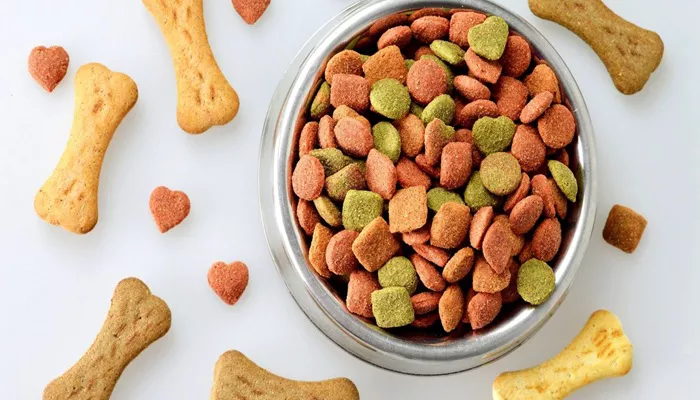Choosing the right dry dog food is crucial for your pet’s health and well-being. With so many options available, it can be overwhelming to determine which one is the best. This article will guide you through the key factors to consider when selecting the healthiest dry dog food for your furry friend.
Understanding Your Dog’s Nutritional Needs
The Basics of Canine Nutrition
Dogs require a balanced diet that includes proteins, fats, carbohydrates, vitamins, and minerals. Each of these nutrients plays a vital role in maintaining your dog’s health.
Proteins: Essential for muscle development and repair.
Fats: Provide energy and support skin and coat health.
Carbohydrates: Offer a quick source of energy.
Vitamins and Minerals: Necessary for various bodily functions, including immune support and bone health.
Life Stage Considerations
Different life stages require different nutritional needs. Puppies, adult dogs, and senior dogs all have unique dietary requirements.
Puppies: Need higher protein and fat content for growth.
Adult Dogs: Require a balanced diet to maintain health.
Senior Dogs: May need lower calorie content to prevent obesity and support joint health.
Key Ingredients to Look For
High-Quality Protein Sources
The first ingredient in dry dog food should be a high-quality protein source. Look for named meat sources like chicken, beef, or lamb.
Chicken: A common and highly digestible protein source.
Beef: Rich in essential amino acids.
Lamb: Often used in hypoallergenic diets.
Healthy Fats
Fats are essential for your dog’s energy and coat health. Look for sources like chicken fat, fish oil, and flaxseed.
Chicken Fat: Provides a concentrated source of energy.
Fish Oil: Rich in omega-3 fatty acids, which support skin and coat health.
Flaxseed: A plant-based source of omega-3s.
Whole Grains and Vegetables
Carbohydrates should come from whole grains and vegetables rather than fillers like corn and wheat.
Brown Rice: A digestible source of carbohydrates.
Sweet Potatoes: Provide fiber and essential vitamins.
Peas: A good source of protein and fiber.
Essential Vitamins and Minerals
Ensure the dry dog food includes added vitamins and minerals to support overall health.
Vitamin E: An antioxidant that supports immune health.
Calcium: Essential for bone health.
Zinc: Supports skin and coat health.
Avoiding Harmful Ingredients
Artificial Additives
Avoid dry dog foods that contain artificial colors, flavors, and preservatives. These can be harmful to your dog’s health.
BHA/BHT: Common preservatives linked to health issues.
Artificial Colors: Unnecessary and potentially harmful.
Artificial Flavors: Can indicate low-quality ingredients.
Fillers and By-Products
Fillers and by-products offer little nutritional value and can be hard for your dog to digest.
Corn: Often used as a filler but offers little nutritional benefit.
Wheat: Can be difficult for some dogs to digest.
Meat By-Products: Low-quality protein sources.
Top Brands for Healthy Dry Dog Food
Orijen
Orijen is known for its high-quality ingredients and biologically appropriate recipes. Their dry dog food contains a high percentage of meat and fish, making it a great choice for dogs with high protein needs.
Acana
Acana offers a range of dry dog foods that are rich in protein and low in carbohydrates. Their recipes are designed to mimic a dog’s natural diet, with a focus on fresh, regional ingredients.
Blue Buffalo
Blue Buffalo is a popular choice for pet owners looking for high-quality dry dog food. Their recipes include real meat, whole grains, and a blend of vitamins and minerals to support overall health.
Taste of the Wild
Taste of the Wild offers grain-free dry dog food that is rich in protein and includes novel protein sources like bison and venison. Their recipes are designed to provide a balanced diet that supports your dog’s natural instincts.
Wellness Core
Wellness Core offers grain-free dry dog food that is high in protein and low in carbohydrates. Their recipes include a blend of antioxidants, probiotics, and omega fatty acids to support overall health.
How to Transition Your Dog to a New Dry Food
Gradual Transition
When switching your dog to a new dry food, it’s important to do so gradually to avoid digestive upset.
Day 1-2: Mix 25% new food with 75% old food.
Day 3-4: Mix 50% new food with 50% old food.
Day 5-6: Mix 75% new food with 25% old food.
Day 7: Fully transition to the new food.
Monitoring Your Dog’s Health
During the transition, monitor your dog for any signs of digestive upset or allergic reactions. If you notice any issues, consult your veterinarian.
Conclusion
Choosing the healthiest dry dog food for your pet involves understanding their nutritional needs, selecting high-quality ingredients, and avoiding harmful additives. By considering factors like protein sources, healthy fats, and essential vitamins and minerals, you can ensure your dog receives a balanced and nutritious diet. Top brands like Orijen, Acana, Blue Buffalo, Taste of the Wild, and Wellness Core offer excellent options for pet owners seeking the best dry dog food. Remember to transition your dog gradually to a new food and monitor their health throughout the process. With the right dry dog food, you can support your dog’s overall health and well-being for years to come.
Related topics:
How Much Should I Feed My Beagle?
How Long Will Cooked Meat Last In The Fridge?
Is Grain-Free Dog Food Better for My Pet’s Health?


